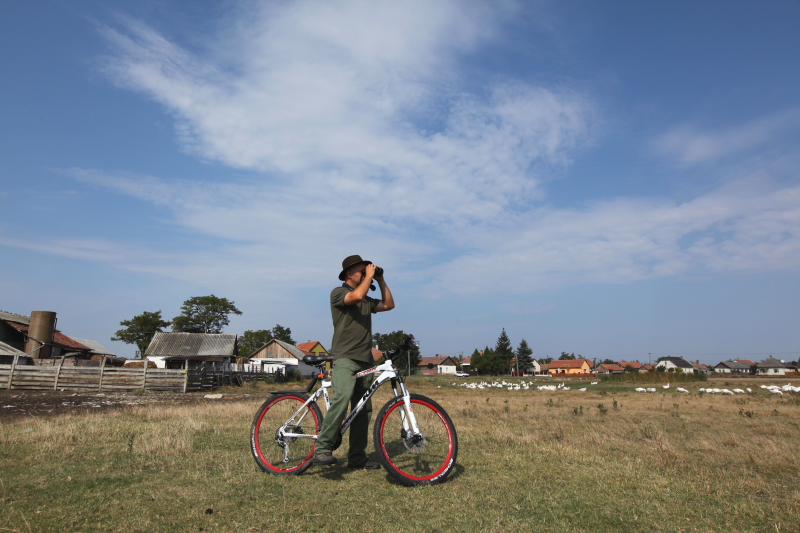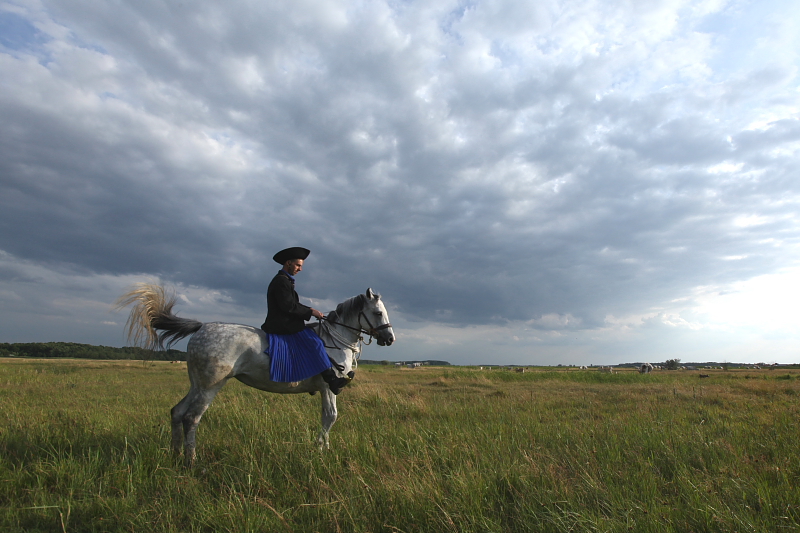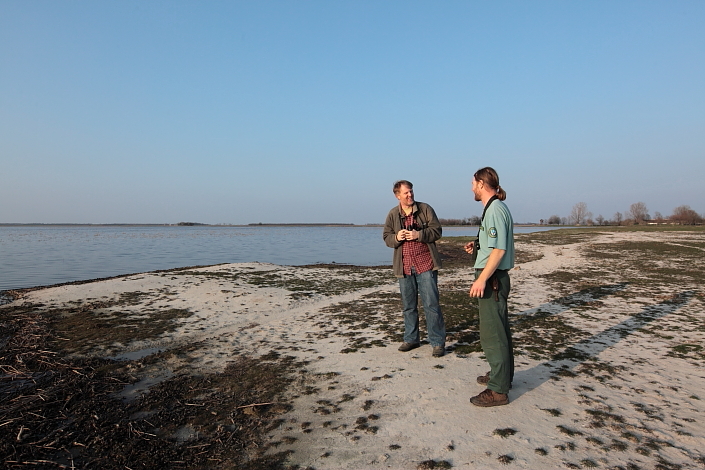
ACTION: E.1:
Overall project operation
The aim of the action is the successful implementation of the project in time according to details of project and the EC’s directions.


Photos: The staff is mainly walking and riding a horse or bike on the project site to keep CO2 emission low (photos: János Oláh)
In 2009: The official start of our project is 4 January and the settlement of the actions is happening with the help of our 5 employees. On the behalf of C0² reduction, our staff is riding a bike or a horse on the project site.
In 2010: There were a few personnel changes but the changes have no influence on the basic mission and goal of the project nor on the contracted job descriptions of the positiones.
Continous coordination’s and meetings were carried out in the following actions: permitted plan (Action A.2.), sewage work recultivation (Action A.3.), land purchase (Action B.2.), cutting of marshy vegetation (Action C.3.), livestock purchasing and organization of the ecologically high level of grazing (Action C.4.), organizing volunteer works (Action C.3., C.4.), coordination with partners (Action B.2., C.4., C.7.), planning of the visitor center (Action D.1.), creation of brochure, reports and publications (Action D.2., D.3.), updating website (Action D.4.), coordination of soda pan surveys (Action D.5.), supplementing, organizing and supervising monitoring work (Action E.2.) and financial planning and execution (all Actions).

Picture: Consultation with a local warden (Photo: János Oláh)
In 2011: There were a few personnel changes but the changes have no influence on the basic mission and goal of the project nor on the contracted job descriptions of the positions. The Mid Term Report has been completed by the end of the year and was sent to the EC.
Budget breakdown categories |
Total cost of |
Costs incurred from the start |
% of total costs |
1. Personnel |
302 174 |
179 826 |
59,5 |
2. Travel and subsistence |
17 722 |
17 490 |
98,7 |
3. External assistance |
598 385 |
84 428 |
14,1 |
4. Durable goods |
|
|
|
Infrastructure |
311 573 |
226 815 |
72,8 |
Equipment |
137 273 |
103 195 |
75,2 |
Prototype |
0 |
|
|
5. Land purchase / long-term lease |
88 379 |
38 054 |
43,1 |
6. Consumables |
40 477 |
56 859 |
140,5 |
7. Other Costs |
43 362 |
29 760 |
68,6 |
8. Overheads |
18 161 |
46 992 |
258,7 |
TOTAL |
1 557 507 |
783 419 |
50,3 |
Table: The breakdown of spending by the project until 1st of November 2011.
In 2012: The overall project operation was running according to original plans with the foreseen quantity and quality colleagues. In 2012 there were no personnel changes and everybody was doing duties according to project proposal and work contracts.
Budget breakdown categories |
Total cost in € |
Costs incurred from the start date to 31.12.2012 in € |
% of total costs |
1. Personnel |
302 174 |
248 106 |
82,1 |
2. Travel and subsistence |
17 722 |
21 600 |
121,8 |
3. External assistance |
598 385 |
475 741 |
79,5 |
4. Durable goods |
|
|
|
Infrastructure |
311 573 |
248 952 |
79,9 |
Equipment |
137 273 |
122 696 |
89,4 |
Prototype |
0 |
|
|
5. Land purchase / long-term lease |
88 379 |
47 597 |
53,9 |
6. Consumables |
40 477 |
85 666 |
211,6 |
7. Other Costs |
43 362 |
49 384 |
113,9 |
8. Overheads |
18 161 |
63 962 |
352,2 |
TOTAL |
1 557 507 |
1 363 704 |
87,5 |
2013: To ensure a smooth operation of the project and achieve the set objectives, five persons were employed full time until 1st June 2013 and four persons were employed full time between 30th June and 31st December 2013. Our 32 page, bilingual Layman’s report was published in 1,000 copies, most of which was distributed among people living next to the project site in Balmazújváros. The project management was in continued contact with the partners (HNPI, FBN, TPF) to ensure that objectives be achieved. Subcontractors and volunteers and casual workers also took part in the implementation of the action. When picking the tools and commissioned parties, the management carried out the required tendering procedures. Despite unforeseen expenses such as non-reimbursement of VAT and exchange rate losses, 100% of the project has been implemented with smaller modifications compared to the project proposal.
